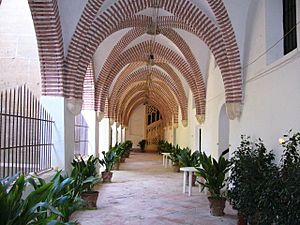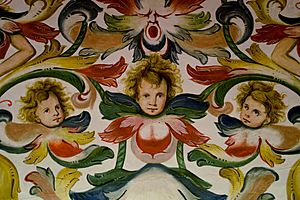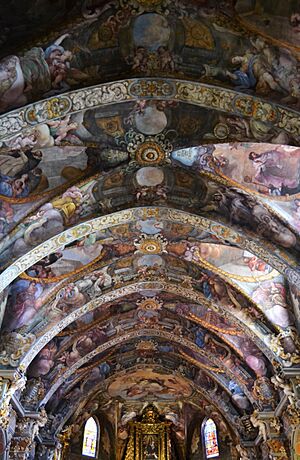Route of the Borgias facts for kids

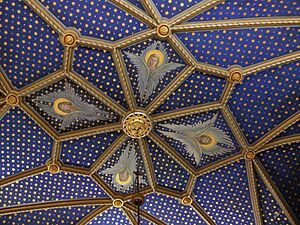

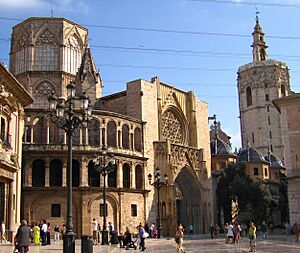
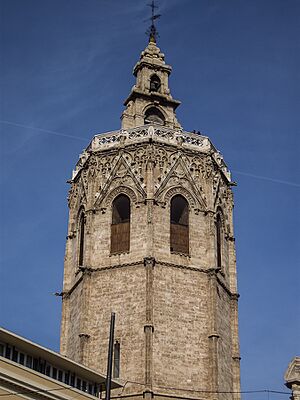
The Route of the Borgias is a special journey through places linked to the famous Borgia family. These places are all found in their home region, the Valencian Community in Spain. This exciting route was officially opened in 2007.
The Borgias were a powerful family who originally came from Aragon. They moved to the Kingdom of Valencia after King James I of Aragon took control from the Moorish rulers. In most languages, you'll hear them called "Borgia." This is the Italian way of saying their original Valencian name, Borja.
Some of the most well-known Borgias include Popes Callixtus III and Alexander VI. There were also Cesare Borgia, Lucrezia Borgia, and Francis Borgia. This family started in towns like Canals and Xàtiva. They later moved to Valencia and even to Rome, before returning to Valencia to restart the Duchy of Gandia.
The Borgia Route begins in the city of Gandia and finishes in Valencia. Along the way, you'll visit many important buildings and towns where the Borgia family left their mark.
Contents
Exploring the Borgia Route
This route takes you through many interesting monuments and towns.
Key Stops on the Route
Here are the main places you can visit:
- Gandia
- Alfauir
- Simat de la Valldigna
- Albaida
- Castelló de Rugat
- Remains of the Ducal Palace
- Canals
- Xàtiva
- Llombai
- Church of the Holy Cross
- Valencia
- Valencia Cathedral
- Palace of the Borgias
- University of Valencia (Estudio General)
- Church of San Nicolás
- Castellnovo (Castellón)
- Castellnovo Castle
Gandia: A Borgia Stronghold
Gandia has many important places connected to the Borgia family.
- The Collegiate Basilica of Gandia was made bigger by Maria Enriquez de Luna. She was the wife of the second duke, Juan Borgia, and the daughter-in-law of Pope Alexander VI. Maria had the Apostles Door built by the famous sculptor Damià Forment. She also had a large altarpiece painted by Paolo da San Leocadio, which is now gone.
- Most of the Borgia dukes were born in the Ducal Palace of Gandia. This palace was built when the Borgias became dukes. You can see the arms courtyard, the crown assembly hall, and the amazing gold gallery. Inside, there's also the "Space of Emotions." This is a virtual center that takes you back to the time of the Borgias.
- The Convent of Santa Clara has a great art collection. The Borgia family gave many artworks to this convent. Many other convents were started from this one, like the Convent of Las Descalzas Reales in Madrid. The pine tower, from the 16th century, was part of the city wall. It was made bigger by the 4th Duke of Gandia, Saint Francis Borgia.
- The Sant Marc Hospital was managed by the Dukes of Gandia. Today, it is the city's archaeological museum (MaGa).
Alfauir: A Peaceful Monastery
- The Monastery of Sant Jeroni de Cotalba was founded in 1388. It is about eight kilometers outside Gandia. In the 16th century, the House of Borgia took care of it. The Duchess of Gandia, Maria Enríquez de Luna, helped pay for the monastery to be made bigger. She added the upper cloister, which is in a late Valencian Gothic style. She also added the medieval water tank in the Orange Tree Patio. Later, Saint Francis Borgia often visited the monastery. His wife, Leonor de Castro, spent her last days there.
Simat de la Valldigna: A Cistercian Gem
- In Simat, you'll find the Monastery of Santa María de la Valldigna. This Cistercian monastery was built in 1298 by Jaime II. Rodrigo Borgia (who became Pope Alexander VI) and his son Cesare were abbots (leaders) of this monastery. You can still see parts like the royal door, the convent, the chapter-house, the cloister, and the abbot's palace. Earthquakes have damaged the church over time, so the one you see today is in a Baroque style.
Albaida: The Cardinal's Palace
- The Palace of Milà i Aragó was built by Cardinal Luis de Milà y de Borja. He was the nephew of Pope Callixtus III. After working for the Pope in Rome, he built this palace in the center of Albaida.
Canals: The Borgia's Birthplace
Canals is an important place for the Borgia family.
- The Tower and walls of the Borgias are here. People say that Alfonso Borgia, who later became Pope Calixtus III, was born in this tower.
- Across from the tower is the Oratory of the Borgias. It has a medieval altarpiece, which is a painted artwork, showing the Last Judgement. Both the tower and the oratory are worth visiting.
Xàtiva: More Borgia History
Xàtiva also has a lot of Borgia history.
- In the Collegiate Basilica of Xàtiva, several Borgia family members are buried. At the museum, you can see an altarpiece from Cardinal Alfonso Borgia. There's also a silver chalice (a special cup) with the name of Pope Calixtus III on it, plus other Borgia artworks.
- The Natal house of Alexander VI is in Xàtiva. Rodrigo Borgia, who became Pope Alexander VI, was born here and was baptized in the church of San Pedro in 1431. You can visit both his birthplace and the church.
- Another Borgia spot in Xàtiva is the Hermitage of Santa Ana. Saint Ana was the family's patron saint (a special protector).
Valencia: The Capital's Borgia Connections
The Borgia family had many connections in Valencia, the capital of the Kingdom of Valencia.
- At the Valencia Cathedral, Pope Callixtus III had the Chapel of "San Pedro" (Saint Peter) built. Before he became Pope, Pope Alexander VI asked the Italian painter Paolo da San Leocadio to paint frescoes (wall paintings) for the dome of the apse. This was an early example of Italian Renaissance painting in Spain. In the chapel for Saint Francis Borgia, there are two paintings by Francisco Goya made for the fourth duke of Gandia.
- The Palace of the Borgias was built by the first duke of Gandia, Pedro Luis Borgia, who was the son of Alexander VI. Today, this palace is where the Valencian Parliament meets.
- The University of Valencia (Estudio General) was started in 1500. This happened thanks to a special order from Pope Alexander VI. Its Renaissance cloister (a covered walkway) is beautiful to see.
- In the Church of San Nicolás, Pope Callixtus III was the rector (leader) before he became Pope. On the door facing San Nicolás square, there are tiles that tell a story. They remember the prediction by Saint Vincent Ferrer that Alfonso de Borja would become Pope and then make him a saint.
See also
 In Spanish: Ruta de los Borja para niños
In Spanish: Ruta de los Borja para niños


